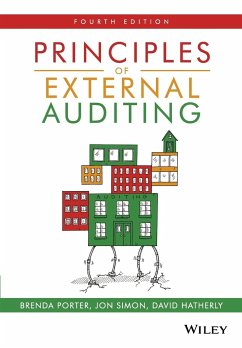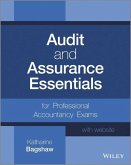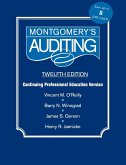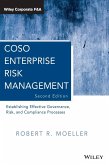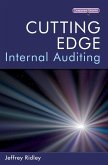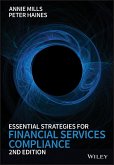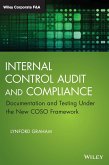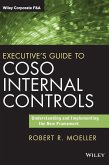- Broschiertes Buch
- Merkliste
- Auf die Merkliste
- Bewerten Bewerten
- Teilen
- Produkt teilen
- Produkterinnerung
- Produkterinnerung
Principles of External Auditing has become established as one of the leading textbooks for students studying auditing. Striking a careful balance between theory and practice, the book describes and explains, in non-technical language, the nature of the audit function and the principles of the audit process.
The book covers international auditing and accounting standards and relevant statute and case law. It explains the fundamental concepts of auditing and takes the reader through the various stages of the audit process. It also discusses topical aspects of auditing such as legal liability,…mehr
Andere Kunden interessierten sich auch für
![Audit and Assurance Essentials, + Website Audit and Assurance Essentials, + Website]() Katharine BagshawAudit and Assurance Essentials, + Website89,99 €
Katharine BagshawAudit and Assurance Essentials, + Website89,99 €![Montgomery Auditing Continuing Professional Education Montgomery Auditing Continuing Professional Education]() Vincent M. O'ReillyMontgomery Auditing Continuing Professional Education209,99 €
Vincent M. O'ReillyMontgomery Auditing Continuing Professional Education209,99 €![COSO Enterprise Risk Management COSO Enterprise Risk Management]() Robert R. MoellerCOSO Enterprise Risk Management69,99 €
Robert R. MoellerCOSO Enterprise Risk Management69,99 €![Cutting Edge Internal Auditing Cutting Edge Internal Auditing]() Jeffrey RidleyCutting Edge Internal Auditing37,99 €
Jeffrey RidleyCutting Edge Internal Auditing37,99 €![Essential Strategies for Financial Services Compliance Essential Strategies for Financial Services Compliance]() Annie MillsEssential Strategies for Financial Services Compliance74,99 €
Annie MillsEssential Strategies for Financial Services Compliance74,99 €![Internal Control Audit and Compliance Internal Control Audit and Compliance]() Lynford GrahamInternal Control Audit and Compliance109,99 €
Lynford GrahamInternal Control Audit and Compliance109,99 €![Executive's Guide to Coso Internal Controls Executive's Guide to Coso Internal Controls]() Robert R. MoellerExecutive's Guide to Coso Internal Controls107,99 €
Robert R. MoellerExecutive's Guide to Coso Internal Controls107,99 €-
-
-
Principles of External Auditing has become established as one of the leading textbooks for students studying auditing. Striking a careful balance between theory and practice, the book describes and explains, in non-technical language, the nature of the audit function and the principles of the audit process.
The book covers international auditing and accounting standards and relevant statute and case law. It explains the fundamental concepts of auditing and takes the reader through the various stages of the audit process. It also discusses topical aspects of auditing such as legal liability, audit risk, quality control, and the impact of information technology.
Brenda Porter is currently visiting Professor at Exeter University and Chulalongkorn University, Bangkok.
Hinweis: Dieser Artikel kann nur an eine deutsche Lieferadresse ausgeliefert werden.
The book covers international auditing and accounting standards and relevant statute and case law. It explains the fundamental concepts of auditing and takes the reader through the various stages of the audit process. It also discusses topical aspects of auditing such as legal liability, audit risk, quality control, and the impact of information technology.
Brenda Porter is currently visiting Professor at Exeter University and Chulalongkorn University, Bangkok.
Hinweis: Dieser Artikel kann nur an eine deutsche Lieferadresse ausgeliefert werden.
Produktdetails
- Produktdetails
- Verlag: Wiley & Sons
- Artikelnr. des Verlages: 14597445000
- 1. Auflage
- Seitenzahl: 896
- Erscheinungstermin: 7. Februar 2014
- Englisch
- Abmessung: 244mm x 170mm x 47mm
- Gewicht: 1484g
- ISBN-13: 9780470974452
- ISBN-10: 0470974451
- Artikelnr.: 38601810
- Herstellerkennzeichnung
- Libri GmbH
- Europaallee 1
- 36244 Bad Hersfeld
- 06621 890
- Verlag: Wiley & Sons
- Artikelnr. des Verlages: 14597445000
- 1. Auflage
- Seitenzahl: 896
- Erscheinungstermin: 7. Februar 2014
- Englisch
- Abmessung: 244mm x 170mm x 47mm
- Gewicht: 1484g
- ISBN-13: 9780470974452
- ISBN-10: 0470974451
- Artikelnr.: 38601810
- Herstellerkennzeichnung
- Libri GmbH
- Europaallee 1
- 36244 Bad Hersfeld
- 06621 890
Brenda Porter is Head of School of Accounting and Law at Victoria University, Wellington New Zealand. Jon Simon is Lecturer in Accounting & Finance at the University of Hull Business School David Hatherly is Professor of Accounting at the University of Edinburgh Management School.
About the Authors xi
Preface xiii
Structure of the Financial Reporting Council xvii
Glossary of Terms xix
1 What is Auditing? 1
1.1 Introduction 1
1.2 What is an audit? 2
1.3 Types of audit 3
1.4 Auditing vs Accounting 8
1.5 Why are external fi nancial statement audits needed? 8
1.6 Benefi ts derived from external fi nancial statement audits 11
1.7 Summary 18
Self-review questions 18
References 19
Additional reading 20
2 The Development of Auditing and Its Objectives 23
2.1 Introduction 23
2.2 Overview of the development of company auditing 23
2.3 Development of auditing in the period up to 1844 26
2.4 Development of company auditing 1844-1920s 27
2.5 Development of company auditing 1920s-1960s 32
2.6 Development of company auditing 1960s-1990s 36
2.7 Development of company auditing 1990s-present 39
2.8 Summary 51
Self-review questions 52
References 53
Additional reading 55
3 A Framework of Auditing Concepts 57
3.1 Introduction 57
3.2 Social purpose, postulates and framework for concepts of auditing 59
3.3 Concepts relating to the credibility of auditors' work 60
3.4 Concepts relating to the audit process 70
3.5 Concept relating to auditors' communication: reporting 86
3.6 Concepts relating to the standard of auditors' performance 90
3.7 Summary 94
Self-review questions 95
References 95
Additional reading 98
4 Threats to, and Safeguarding of, Auditors' Independence 99
4.1 Introduction 99
4.2 Threats to auditors' independence 100
4.3 Steps taken by parliament and regulators to safeguard auditors'
independence 104
4.4 Other proposals to strengthen auditors' independence 140
4.5 Role and responsibilities of audit committees 143
4.6 Summary 151
Self-review questions 152
References 153
Additional reading 157
5 Auditors' Legal, Regulatory and Professional Responsibilities 161
5.1 Introduction 161
5.2 Reporting and auditing requirements of companies 165
5.3 Appointment, remuneration and removal of company auditors 181
5.4 Auditor-client relationship 189
5.5 Auditors' duties and rights 191
5.6 Audit fi rms' transparency reports and governance code 207
5.7 Summary 211
Self-review questions 212
References 213
Additional reading 216
6 Auditors' Duties with Respect to Fraud and Non-compliance with Laws and
Regulations 217
6.1 Introduction 217
6.2 Defi nition of fraud 218
6.3 Development of auditors' responsibility to detect and report fraud 220
6.4 Auditors' current responsibilities to detect and report fraud 229
6.5 Aggressive earnings management 241
6.6 Auditors' responsibility to detect and report non-compliance with laws
and regulations 242
6.7 Auditors' duty of confi dentiality to their clients 250
6.8 Summary 253
Self-review questions 254
References 255
Additional reading 257
Appendix: Examples of fraud risk factors 258
7 Overview of the Audit Process, Audit Evidence, Staffing and Documenting
an Audit 261
7.1 Introduction 261
7.2 Overview of the audit process 262
7.3 Clarification of some jargon 265
7.4 Audit evidence 271
7.5 Staffi ng an audit 277
7.6 Documenting an audit 289
7.7 Summary 306
Self-review questions 307
References 309
Additional reading 310
8 Commencing an Audit: Engagement Procedures, Understanding the Client and
Identifying Risks 311
8.1 Introduction 311
8.2 Pre-engagement investigation 312
8.3 Audit engagement letters 320
8.4 Understanding the client, its business and its industry and how it
evaluates its performance 325
8.5 Identifying and assessing risks of material misstatement in the
financial statements 332
8.6 Analytical procedures 336
8.7 Summary 340
Self-review questions 341
References 342
Additional reading 342
9 Planning the Audit; Materiality and Audit Risk 345
9.1 Introduction 345
9.2 Phases of planning an audit 346
9.3 Impact of materiality on planning an audit 350
9.4 Desired level of audit risk (desired level of assurance) 362
9.5 Impact of audit risk on planning the audit 366
9.6 Summary 375
Self-review questions 377
References 377
Additional reading 378
10 Internal Control and the External Audit 381
10.1 Introduction 381
10.2 The accounting system 382
10.3 Conceptual aspects of internal control 385
10.4 Reviewing the accounting system and evaluating its internal controls
402
10.5 Developing the audit plan 411
10.6 Compliance testing 415
10.7 Reporting internal control deficiencies to management 419
10.8 Summary 420
Self-review questions 421
References 422
Additional reading 423
11 Testing Financial Statement Assertions: Substantive Testing 425
11.1 Introduction 425
11.2 Significance of substantive testing in the audit process 426
11.3 Objectives of, and approaches to, substantive testing 428
11.4 Substantive audit procedures 433
11.5 Requirements of auditors when misstatements are detected 441
11.6 Introduction to substantive testing of inventory and accounts
receivable 443
11.7 Signifi cant aspects of auditing inventory 444
11.8 Signifi cant aspects of auditing accounts receivable 452
11.9 Initial engagements 462
11.10 Summary 463
Self-review questions 463
References 464
Additional reading 465
12 Audit Sampling and Computer Assisted Auditing Techniques (CAATs) 467
12.1 Introduction 467
12.2 Meaning and importance of sampling in auditing 468
12.3 Basic terminology relating to sampling 470
12.4 Judgmental sampling vs statistical sampling and sampling methods 472
12.5 Designing and selecting samples 474
12.6 Judgmental sampling 481
12.7 Statistical sampling of attributes and variables, and pps sampling 482
12.8 Following up sample results 490
12.9 Computer assisted audit techniques 491
12.10 Summary 495
Self-review questions 496
References 497
Additional reading 497
13 Completion and Review 499
13.1 Introduction 499
13.2 Review for contingent liabilities and commitments 501
13.3 Review for subsequent events 503
13.4 (re)Assessment of the going concern assumption 508
13.5 Written representations 520
13.6 Final review of the fi nancial statements 527
13.7 Evaluation of audit evidence gathered and formation of the audit
opinion 530
13.8 Review of unaudited information 533
13.9 Final conference 537
13.10 Summary 537
Self-review questions 538
References 539
Additional reading 540
14 Auditors' Reports to Users of Financial Statements and to Management 543
14.1 Introduction 543
14.2 Auditors' reporting obligations under the companies act 2006 544
14.3 Format and content of audit reports 549
14.4 Types of audit opinion 564
14.5 Different forms of modifi ed audit opinion 566
14.6 Emphasis of matter and other matter paragraphs 576
14.7 The audit report - the auditor's chance to communicate 580
14.8 Auditors' communication with those charged with governance 590
14.9 Summary 603
Self-review questions 604
References 605
Additional reading 609
15 Legal Liability of Auditors 611
15.1 Introduction 611
15.2 Overview of auditors' legal liability 612
15.3 Auditors' contractual liability to their clients 615
15.4 Liability to third parties under the common law 622
15.5 The effect of out-of-court settlements 661
15.6 Summary 663
Self-review questions 663
References 664
Additional reading 666
Appendix 1 667
Appendix 2 669
16 Avoiding and Limiting Auditors' Liability 673
16.1 Introduction 673
16.2 Importance of, and responsibility for, quality control of audits 675
16.3 The profession's measures to secure high quality audits 676
16.4 Regulators' measures for securing high quality audits 689
16.5 Proposals for limiting auditors' liability 708
16.6 Summary 720
Self-review questions 721
References 722
Additional reading 725
17 Corporate Responsibility Reporting and Assurance 727
17.1 Introduction 727
17.2 Development of corporate responsibility reporting 729
17.3 Why do companies publish corporate responsibility reports? 733
17.4 Corporate responsibility reporting guidelines 743
17.5 Corporate responsibility assurance engagements 746
17.6 Why do some companies have their corporate responsibility reports
independently assured while others do not? 763
17.7 Relevance of corporate responsibility issues to external financial
statement audits 766
17.8 Summary 772
Self-review questions 773
References 774
Additional reading 777
Appendix: Brief descriptions of 'responsible investment' indices 777
18 The Audit Expectation-Performance Gap and Proposals for Reforming the
External Audit Function 783
18.1 Introduction 783
18.2 The audit expectation-performance gap 784
18.3 Overview of proposed reforms following the global financial crisis 798
18.4 Enhancing auditors' reporting responsibilities 799
18.5 Audit market concentration and strengthening auditors' independence
816
18.6 Emergence of competition from china 837
18.7 Inherent conflicts in the current audit model 839
18.8 Summary 841
Self-review questions 842
References 843
Additional reading 849
Index 851
Preface xiii
Structure of the Financial Reporting Council xvii
Glossary of Terms xix
1 What is Auditing? 1
1.1 Introduction 1
1.2 What is an audit? 2
1.3 Types of audit 3
1.4 Auditing vs Accounting 8
1.5 Why are external fi nancial statement audits needed? 8
1.6 Benefi ts derived from external fi nancial statement audits 11
1.7 Summary 18
Self-review questions 18
References 19
Additional reading 20
2 The Development of Auditing and Its Objectives 23
2.1 Introduction 23
2.2 Overview of the development of company auditing 23
2.3 Development of auditing in the period up to 1844 26
2.4 Development of company auditing 1844-1920s 27
2.5 Development of company auditing 1920s-1960s 32
2.6 Development of company auditing 1960s-1990s 36
2.7 Development of company auditing 1990s-present 39
2.8 Summary 51
Self-review questions 52
References 53
Additional reading 55
3 A Framework of Auditing Concepts 57
3.1 Introduction 57
3.2 Social purpose, postulates and framework for concepts of auditing 59
3.3 Concepts relating to the credibility of auditors' work 60
3.4 Concepts relating to the audit process 70
3.5 Concept relating to auditors' communication: reporting 86
3.6 Concepts relating to the standard of auditors' performance 90
3.7 Summary 94
Self-review questions 95
References 95
Additional reading 98
4 Threats to, and Safeguarding of, Auditors' Independence 99
4.1 Introduction 99
4.2 Threats to auditors' independence 100
4.3 Steps taken by parliament and regulators to safeguard auditors'
independence 104
4.4 Other proposals to strengthen auditors' independence 140
4.5 Role and responsibilities of audit committees 143
4.6 Summary 151
Self-review questions 152
References 153
Additional reading 157
5 Auditors' Legal, Regulatory and Professional Responsibilities 161
5.1 Introduction 161
5.2 Reporting and auditing requirements of companies 165
5.3 Appointment, remuneration and removal of company auditors 181
5.4 Auditor-client relationship 189
5.5 Auditors' duties and rights 191
5.6 Audit fi rms' transparency reports and governance code 207
5.7 Summary 211
Self-review questions 212
References 213
Additional reading 216
6 Auditors' Duties with Respect to Fraud and Non-compliance with Laws and
Regulations 217
6.1 Introduction 217
6.2 Defi nition of fraud 218
6.3 Development of auditors' responsibility to detect and report fraud 220
6.4 Auditors' current responsibilities to detect and report fraud 229
6.5 Aggressive earnings management 241
6.6 Auditors' responsibility to detect and report non-compliance with laws
and regulations 242
6.7 Auditors' duty of confi dentiality to their clients 250
6.8 Summary 253
Self-review questions 254
References 255
Additional reading 257
Appendix: Examples of fraud risk factors 258
7 Overview of the Audit Process, Audit Evidence, Staffing and Documenting
an Audit 261
7.1 Introduction 261
7.2 Overview of the audit process 262
7.3 Clarification of some jargon 265
7.4 Audit evidence 271
7.5 Staffi ng an audit 277
7.6 Documenting an audit 289
7.7 Summary 306
Self-review questions 307
References 309
Additional reading 310
8 Commencing an Audit: Engagement Procedures, Understanding the Client and
Identifying Risks 311
8.1 Introduction 311
8.2 Pre-engagement investigation 312
8.3 Audit engagement letters 320
8.4 Understanding the client, its business and its industry and how it
evaluates its performance 325
8.5 Identifying and assessing risks of material misstatement in the
financial statements 332
8.6 Analytical procedures 336
8.7 Summary 340
Self-review questions 341
References 342
Additional reading 342
9 Planning the Audit; Materiality and Audit Risk 345
9.1 Introduction 345
9.2 Phases of planning an audit 346
9.3 Impact of materiality on planning an audit 350
9.4 Desired level of audit risk (desired level of assurance) 362
9.5 Impact of audit risk on planning the audit 366
9.6 Summary 375
Self-review questions 377
References 377
Additional reading 378
10 Internal Control and the External Audit 381
10.1 Introduction 381
10.2 The accounting system 382
10.3 Conceptual aspects of internal control 385
10.4 Reviewing the accounting system and evaluating its internal controls
402
10.5 Developing the audit plan 411
10.6 Compliance testing 415
10.7 Reporting internal control deficiencies to management 419
10.8 Summary 420
Self-review questions 421
References 422
Additional reading 423
11 Testing Financial Statement Assertions: Substantive Testing 425
11.1 Introduction 425
11.2 Significance of substantive testing in the audit process 426
11.3 Objectives of, and approaches to, substantive testing 428
11.4 Substantive audit procedures 433
11.5 Requirements of auditors when misstatements are detected 441
11.6 Introduction to substantive testing of inventory and accounts
receivable 443
11.7 Signifi cant aspects of auditing inventory 444
11.8 Signifi cant aspects of auditing accounts receivable 452
11.9 Initial engagements 462
11.10 Summary 463
Self-review questions 463
References 464
Additional reading 465
12 Audit Sampling and Computer Assisted Auditing Techniques (CAATs) 467
12.1 Introduction 467
12.2 Meaning and importance of sampling in auditing 468
12.3 Basic terminology relating to sampling 470
12.4 Judgmental sampling vs statistical sampling and sampling methods 472
12.5 Designing and selecting samples 474
12.6 Judgmental sampling 481
12.7 Statistical sampling of attributes and variables, and pps sampling 482
12.8 Following up sample results 490
12.9 Computer assisted audit techniques 491
12.10 Summary 495
Self-review questions 496
References 497
Additional reading 497
13 Completion and Review 499
13.1 Introduction 499
13.2 Review for contingent liabilities and commitments 501
13.3 Review for subsequent events 503
13.4 (re)Assessment of the going concern assumption 508
13.5 Written representations 520
13.6 Final review of the fi nancial statements 527
13.7 Evaluation of audit evidence gathered and formation of the audit
opinion 530
13.8 Review of unaudited information 533
13.9 Final conference 537
13.10 Summary 537
Self-review questions 538
References 539
Additional reading 540
14 Auditors' Reports to Users of Financial Statements and to Management 543
14.1 Introduction 543
14.2 Auditors' reporting obligations under the companies act 2006 544
14.3 Format and content of audit reports 549
14.4 Types of audit opinion 564
14.5 Different forms of modifi ed audit opinion 566
14.6 Emphasis of matter and other matter paragraphs 576
14.7 The audit report - the auditor's chance to communicate 580
14.8 Auditors' communication with those charged with governance 590
14.9 Summary 603
Self-review questions 604
References 605
Additional reading 609
15 Legal Liability of Auditors 611
15.1 Introduction 611
15.2 Overview of auditors' legal liability 612
15.3 Auditors' contractual liability to their clients 615
15.4 Liability to third parties under the common law 622
15.5 The effect of out-of-court settlements 661
15.6 Summary 663
Self-review questions 663
References 664
Additional reading 666
Appendix 1 667
Appendix 2 669
16 Avoiding and Limiting Auditors' Liability 673
16.1 Introduction 673
16.2 Importance of, and responsibility for, quality control of audits 675
16.3 The profession's measures to secure high quality audits 676
16.4 Regulators' measures for securing high quality audits 689
16.5 Proposals for limiting auditors' liability 708
16.6 Summary 720
Self-review questions 721
References 722
Additional reading 725
17 Corporate Responsibility Reporting and Assurance 727
17.1 Introduction 727
17.2 Development of corporate responsibility reporting 729
17.3 Why do companies publish corporate responsibility reports? 733
17.4 Corporate responsibility reporting guidelines 743
17.5 Corporate responsibility assurance engagements 746
17.6 Why do some companies have their corporate responsibility reports
independently assured while others do not? 763
17.7 Relevance of corporate responsibility issues to external financial
statement audits 766
17.8 Summary 772
Self-review questions 773
References 774
Additional reading 777
Appendix: Brief descriptions of 'responsible investment' indices 777
18 The Audit Expectation-Performance Gap and Proposals for Reforming the
External Audit Function 783
18.1 Introduction 783
18.2 The audit expectation-performance gap 784
18.3 Overview of proposed reforms following the global financial crisis 798
18.4 Enhancing auditors' reporting responsibilities 799
18.5 Audit market concentration and strengthening auditors' independence
816
18.6 Emergence of competition from china 837
18.7 Inherent conflicts in the current audit model 839
18.8 Summary 841
Self-review questions 842
References 843
Additional reading 849
Index 851
About the Authors xi
Preface xiii
Structure of the Financial Reporting Council xvii
Glossary of Terms xix
1 What is Auditing? 1
1.1 Introduction 1
1.2 What is an audit? 2
1.3 Types of audit 3
1.4 Auditing vs Accounting 8
1.5 Why are external fi nancial statement audits needed? 8
1.6 Benefi ts derived from external fi nancial statement audits 11
1.7 Summary 18
Self-review questions 18
References 19
Additional reading 20
2 The Development of Auditing and Its Objectives 23
2.1 Introduction 23
2.2 Overview of the development of company auditing 23
2.3 Development of auditing in the period up to 1844 26
2.4 Development of company auditing 1844-1920s 27
2.5 Development of company auditing 1920s-1960s 32
2.6 Development of company auditing 1960s-1990s 36
2.7 Development of company auditing 1990s-present 39
2.8 Summary 51
Self-review questions 52
References 53
Additional reading 55
3 A Framework of Auditing Concepts 57
3.1 Introduction 57
3.2 Social purpose, postulates and framework for concepts of auditing 59
3.3 Concepts relating to the credibility of auditors' work 60
3.4 Concepts relating to the audit process 70
3.5 Concept relating to auditors' communication: reporting 86
3.6 Concepts relating to the standard of auditors' performance 90
3.7 Summary 94
Self-review questions 95
References 95
Additional reading 98
4 Threats to, and Safeguarding of, Auditors' Independence 99
4.1 Introduction 99
4.2 Threats to auditors' independence 100
4.3 Steps taken by parliament and regulators to safeguard auditors'
independence 104
4.4 Other proposals to strengthen auditors' independence 140
4.5 Role and responsibilities of audit committees 143
4.6 Summary 151
Self-review questions 152
References 153
Additional reading 157
5 Auditors' Legal, Regulatory and Professional Responsibilities 161
5.1 Introduction 161
5.2 Reporting and auditing requirements of companies 165
5.3 Appointment, remuneration and removal of company auditors 181
5.4 Auditor-client relationship 189
5.5 Auditors' duties and rights 191
5.6 Audit fi rms' transparency reports and governance code 207
5.7 Summary 211
Self-review questions 212
References 213
Additional reading 216
6 Auditors' Duties with Respect to Fraud and Non-compliance with Laws and
Regulations 217
6.1 Introduction 217
6.2 Defi nition of fraud 218
6.3 Development of auditors' responsibility to detect and report fraud 220
6.4 Auditors' current responsibilities to detect and report fraud 229
6.5 Aggressive earnings management 241
6.6 Auditors' responsibility to detect and report non-compliance with laws
and regulations 242
6.7 Auditors' duty of confi dentiality to their clients 250
6.8 Summary 253
Self-review questions 254
References 255
Additional reading 257
Appendix: Examples of fraud risk factors 258
7 Overview of the Audit Process, Audit Evidence, Staffing and Documenting
an Audit 261
7.1 Introduction 261
7.2 Overview of the audit process 262
7.3 Clarification of some jargon 265
7.4 Audit evidence 271
7.5 Staffi ng an audit 277
7.6 Documenting an audit 289
7.7 Summary 306
Self-review questions 307
References 309
Additional reading 310
8 Commencing an Audit: Engagement Procedures, Understanding the Client and
Identifying Risks 311
8.1 Introduction 311
8.2 Pre-engagement investigation 312
8.3 Audit engagement letters 320
8.4 Understanding the client, its business and its industry and how it
evaluates its performance 325
8.5 Identifying and assessing risks of material misstatement in the
financial statements 332
8.6 Analytical procedures 336
8.7 Summary 340
Self-review questions 341
References 342
Additional reading 342
9 Planning the Audit; Materiality and Audit Risk 345
9.1 Introduction 345
9.2 Phases of planning an audit 346
9.3 Impact of materiality on planning an audit 350
9.4 Desired level of audit risk (desired level of assurance) 362
9.5 Impact of audit risk on planning the audit 366
9.6 Summary 375
Self-review questions 377
References 377
Additional reading 378
10 Internal Control and the External Audit 381
10.1 Introduction 381
10.2 The accounting system 382
10.3 Conceptual aspects of internal control 385
10.4 Reviewing the accounting system and evaluating its internal controls
402
10.5 Developing the audit plan 411
10.6 Compliance testing 415
10.7 Reporting internal control deficiencies to management 419
10.8 Summary 420
Self-review questions 421
References 422
Additional reading 423
11 Testing Financial Statement Assertions: Substantive Testing 425
11.1 Introduction 425
11.2 Significance of substantive testing in the audit process 426
11.3 Objectives of, and approaches to, substantive testing 428
11.4 Substantive audit procedures 433
11.5 Requirements of auditors when misstatements are detected 441
11.6 Introduction to substantive testing of inventory and accounts
receivable 443
11.7 Signifi cant aspects of auditing inventory 444
11.8 Signifi cant aspects of auditing accounts receivable 452
11.9 Initial engagements 462
11.10 Summary 463
Self-review questions 463
References 464
Additional reading 465
12 Audit Sampling and Computer Assisted Auditing Techniques (CAATs) 467
12.1 Introduction 467
12.2 Meaning and importance of sampling in auditing 468
12.3 Basic terminology relating to sampling 470
12.4 Judgmental sampling vs statistical sampling and sampling methods 472
12.5 Designing and selecting samples 474
12.6 Judgmental sampling 481
12.7 Statistical sampling of attributes and variables, and pps sampling 482
12.8 Following up sample results 490
12.9 Computer assisted audit techniques 491
12.10 Summary 495
Self-review questions 496
References 497
Additional reading 497
13 Completion and Review 499
13.1 Introduction 499
13.2 Review for contingent liabilities and commitments 501
13.3 Review for subsequent events 503
13.4 (re)Assessment of the going concern assumption 508
13.5 Written representations 520
13.6 Final review of the fi nancial statements 527
13.7 Evaluation of audit evidence gathered and formation of the audit
opinion 530
13.8 Review of unaudited information 533
13.9 Final conference 537
13.10 Summary 537
Self-review questions 538
References 539
Additional reading 540
14 Auditors' Reports to Users of Financial Statements and to Management 543
14.1 Introduction 543
14.2 Auditors' reporting obligations under the companies act 2006 544
14.3 Format and content of audit reports 549
14.4 Types of audit opinion 564
14.5 Different forms of modifi ed audit opinion 566
14.6 Emphasis of matter and other matter paragraphs 576
14.7 The audit report - the auditor's chance to communicate 580
14.8 Auditors' communication with those charged with governance 590
14.9 Summary 603
Self-review questions 604
References 605
Additional reading 609
15 Legal Liability of Auditors 611
15.1 Introduction 611
15.2 Overview of auditors' legal liability 612
15.3 Auditors' contractual liability to their clients 615
15.4 Liability to third parties under the common law 622
15.5 The effect of out-of-court settlements 661
15.6 Summary 663
Self-review questions 663
References 664
Additional reading 666
Appendix 1 667
Appendix 2 669
16 Avoiding and Limiting Auditors' Liability 673
16.1 Introduction 673
16.2 Importance of, and responsibility for, quality control of audits 675
16.3 The profession's measures to secure high quality audits 676
16.4 Regulators' measures for securing high quality audits 689
16.5 Proposals for limiting auditors' liability 708
16.6 Summary 720
Self-review questions 721
References 722
Additional reading 725
17 Corporate Responsibility Reporting and Assurance 727
17.1 Introduction 727
17.2 Development of corporate responsibility reporting 729
17.3 Why do companies publish corporate responsibility reports? 733
17.4 Corporate responsibility reporting guidelines 743
17.5 Corporate responsibility assurance engagements 746
17.6 Why do some companies have their corporate responsibility reports
independently assured while others do not? 763
17.7 Relevance of corporate responsibility issues to external financial
statement audits 766
17.8 Summary 772
Self-review questions 773
References 774
Additional reading 777
Appendix: Brief descriptions of 'responsible investment' indices 777
18 The Audit Expectation-Performance Gap and Proposals for Reforming the
External Audit Function 783
18.1 Introduction 783
18.2 The audit expectation-performance gap 784
18.3 Overview of proposed reforms following the global financial crisis 798
18.4 Enhancing auditors' reporting responsibilities 799
18.5 Audit market concentration and strengthening auditors' independence
816
18.6 Emergence of competition from china 837
18.7 Inherent conflicts in the current audit model 839
18.8 Summary 841
Self-review questions 842
References 843
Additional reading 849
Index 851
Preface xiii
Structure of the Financial Reporting Council xvii
Glossary of Terms xix
1 What is Auditing? 1
1.1 Introduction 1
1.2 What is an audit? 2
1.3 Types of audit 3
1.4 Auditing vs Accounting 8
1.5 Why are external fi nancial statement audits needed? 8
1.6 Benefi ts derived from external fi nancial statement audits 11
1.7 Summary 18
Self-review questions 18
References 19
Additional reading 20
2 The Development of Auditing and Its Objectives 23
2.1 Introduction 23
2.2 Overview of the development of company auditing 23
2.3 Development of auditing in the period up to 1844 26
2.4 Development of company auditing 1844-1920s 27
2.5 Development of company auditing 1920s-1960s 32
2.6 Development of company auditing 1960s-1990s 36
2.7 Development of company auditing 1990s-present 39
2.8 Summary 51
Self-review questions 52
References 53
Additional reading 55
3 A Framework of Auditing Concepts 57
3.1 Introduction 57
3.2 Social purpose, postulates and framework for concepts of auditing 59
3.3 Concepts relating to the credibility of auditors' work 60
3.4 Concepts relating to the audit process 70
3.5 Concept relating to auditors' communication: reporting 86
3.6 Concepts relating to the standard of auditors' performance 90
3.7 Summary 94
Self-review questions 95
References 95
Additional reading 98
4 Threats to, and Safeguarding of, Auditors' Independence 99
4.1 Introduction 99
4.2 Threats to auditors' independence 100
4.3 Steps taken by parliament and regulators to safeguard auditors'
independence 104
4.4 Other proposals to strengthen auditors' independence 140
4.5 Role and responsibilities of audit committees 143
4.6 Summary 151
Self-review questions 152
References 153
Additional reading 157
5 Auditors' Legal, Regulatory and Professional Responsibilities 161
5.1 Introduction 161
5.2 Reporting and auditing requirements of companies 165
5.3 Appointment, remuneration and removal of company auditors 181
5.4 Auditor-client relationship 189
5.5 Auditors' duties and rights 191
5.6 Audit fi rms' transparency reports and governance code 207
5.7 Summary 211
Self-review questions 212
References 213
Additional reading 216
6 Auditors' Duties with Respect to Fraud and Non-compliance with Laws and
Regulations 217
6.1 Introduction 217
6.2 Defi nition of fraud 218
6.3 Development of auditors' responsibility to detect and report fraud 220
6.4 Auditors' current responsibilities to detect and report fraud 229
6.5 Aggressive earnings management 241
6.6 Auditors' responsibility to detect and report non-compliance with laws
and regulations 242
6.7 Auditors' duty of confi dentiality to their clients 250
6.8 Summary 253
Self-review questions 254
References 255
Additional reading 257
Appendix: Examples of fraud risk factors 258
7 Overview of the Audit Process, Audit Evidence, Staffing and Documenting
an Audit 261
7.1 Introduction 261
7.2 Overview of the audit process 262
7.3 Clarification of some jargon 265
7.4 Audit evidence 271
7.5 Staffi ng an audit 277
7.6 Documenting an audit 289
7.7 Summary 306
Self-review questions 307
References 309
Additional reading 310
8 Commencing an Audit: Engagement Procedures, Understanding the Client and
Identifying Risks 311
8.1 Introduction 311
8.2 Pre-engagement investigation 312
8.3 Audit engagement letters 320
8.4 Understanding the client, its business and its industry and how it
evaluates its performance 325
8.5 Identifying and assessing risks of material misstatement in the
financial statements 332
8.6 Analytical procedures 336
8.7 Summary 340
Self-review questions 341
References 342
Additional reading 342
9 Planning the Audit; Materiality and Audit Risk 345
9.1 Introduction 345
9.2 Phases of planning an audit 346
9.3 Impact of materiality on planning an audit 350
9.4 Desired level of audit risk (desired level of assurance) 362
9.5 Impact of audit risk on planning the audit 366
9.6 Summary 375
Self-review questions 377
References 377
Additional reading 378
10 Internal Control and the External Audit 381
10.1 Introduction 381
10.2 The accounting system 382
10.3 Conceptual aspects of internal control 385
10.4 Reviewing the accounting system and evaluating its internal controls
402
10.5 Developing the audit plan 411
10.6 Compliance testing 415
10.7 Reporting internal control deficiencies to management 419
10.8 Summary 420
Self-review questions 421
References 422
Additional reading 423
11 Testing Financial Statement Assertions: Substantive Testing 425
11.1 Introduction 425
11.2 Significance of substantive testing in the audit process 426
11.3 Objectives of, and approaches to, substantive testing 428
11.4 Substantive audit procedures 433
11.5 Requirements of auditors when misstatements are detected 441
11.6 Introduction to substantive testing of inventory and accounts
receivable 443
11.7 Signifi cant aspects of auditing inventory 444
11.8 Signifi cant aspects of auditing accounts receivable 452
11.9 Initial engagements 462
11.10 Summary 463
Self-review questions 463
References 464
Additional reading 465
12 Audit Sampling and Computer Assisted Auditing Techniques (CAATs) 467
12.1 Introduction 467
12.2 Meaning and importance of sampling in auditing 468
12.3 Basic terminology relating to sampling 470
12.4 Judgmental sampling vs statistical sampling and sampling methods 472
12.5 Designing and selecting samples 474
12.6 Judgmental sampling 481
12.7 Statistical sampling of attributes and variables, and pps sampling 482
12.8 Following up sample results 490
12.9 Computer assisted audit techniques 491
12.10 Summary 495
Self-review questions 496
References 497
Additional reading 497
13 Completion and Review 499
13.1 Introduction 499
13.2 Review for contingent liabilities and commitments 501
13.3 Review for subsequent events 503
13.4 (re)Assessment of the going concern assumption 508
13.5 Written representations 520
13.6 Final review of the fi nancial statements 527
13.7 Evaluation of audit evidence gathered and formation of the audit
opinion 530
13.8 Review of unaudited information 533
13.9 Final conference 537
13.10 Summary 537
Self-review questions 538
References 539
Additional reading 540
14 Auditors' Reports to Users of Financial Statements and to Management 543
14.1 Introduction 543
14.2 Auditors' reporting obligations under the companies act 2006 544
14.3 Format and content of audit reports 549
14.4 Types of audit opinion 564
14.5 Different forms of modifi ed audit opinion 566
14.6 Emphasis of matter and other matter paragraphs 576
14.7 The audit report - the auditor's chance to communicate 580
14.8 Auditors' communication with those charged with governance 590
14.9 Summary 603
Self-review questions 604
References 605
Additional reading 609
15 Legal Liability of Auditors 611
15.1 Introduction 611
15.2 Overview of auditors' legal liability 612
15.3 Auditors' contractual liability to their clients 615
15.4 Liability to third parties under the common law 622
15.5 The effect of out-of-court settlements 661
15.6 Summary 663
Self-review questions 663
References 664
Additional reading 666
Appendix 1 667
Appendix 2 669
16 Avoiding and Limiting Auditors' Liability 673
16.1 Introduction 673
16.2 Importance of, and responsibility for, quality control of audits 675
16.3 The profession's measures to secure high quality audits 676
16.4 Regulators' measures for securing high quality audits 689
16.5 Proposals for limiting auditors' liability 708
16.6 Summary 720
Self-review questions 721
References 722
Additional reading 725
17 Corporate Responsibility Reporting and Assurance 727
17.1 Introduction 727
17.2 Development of corporate responsibility reporting 729
17.3 Why do companies publish corporate responsibility reports? 733
17.4 Corporate responsibility reporting guidelines 743
17.5 Corporate responsibility assurance engagements 746
17.6 Why do some companies have their corporate responsibility reports
independently assured while others do not? 763
17.7 Relevance of corporate responsibility issues to external financial
statement audits 766
17.8 Summary 772
Self-review questions 773
References 774
Additional reading 777
Appendix: Brief descriptions of 'responsible investment' indices 777
18 The Audit Expectation-Performance Gap and Proposals for Reforming the
External Audit Function 783
18.1 Introduction 783
18.2 The audit expectation-performance gap 784
18.3 Overview of proposed reforms following the global financial crisis 798
18.4 Enhancing auditors' reporting responsibilities 799
18.5 Audit market concentration and strengthening auditors' independence
816
18.6 Emergence of competition from china 837
18.7 Inherent conflicts in the current audit model 839
18.8 Summary 841
Self-review questions 842
References 843
Additional reading 849
Index 851

